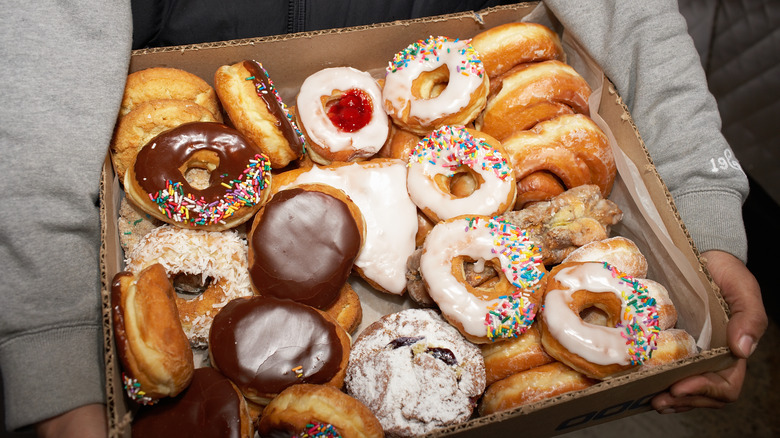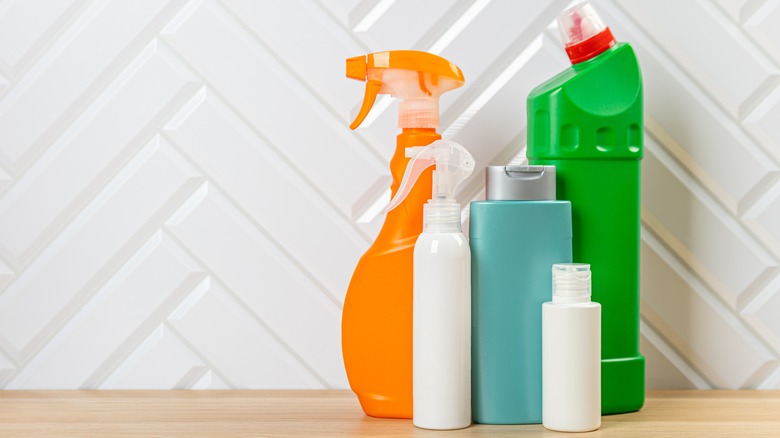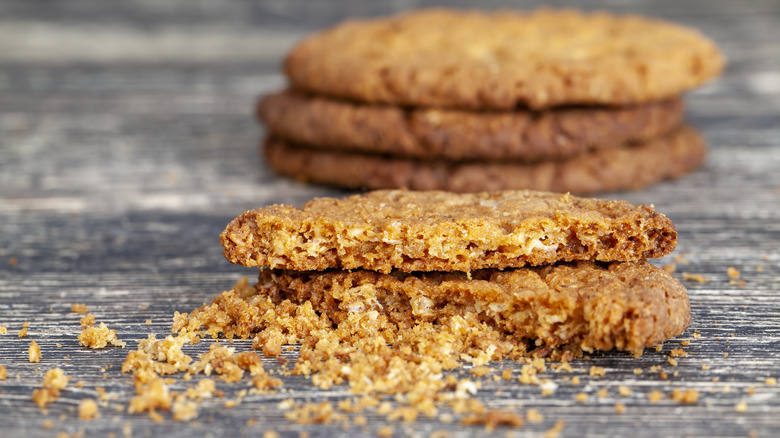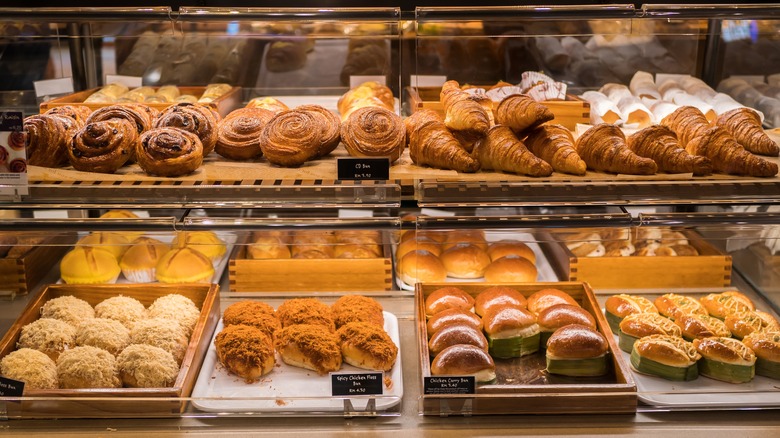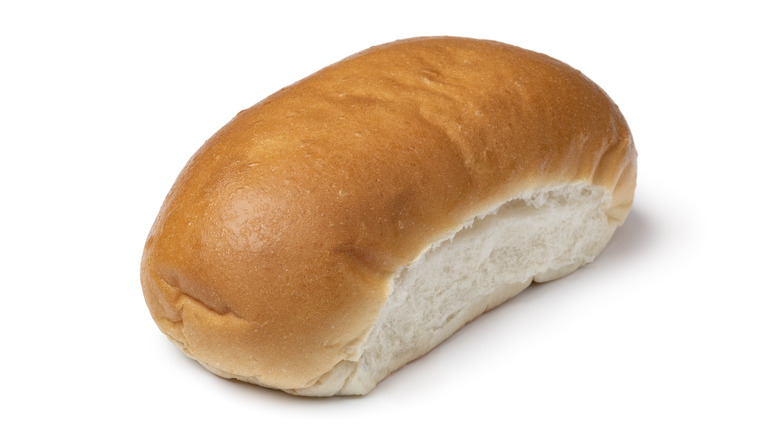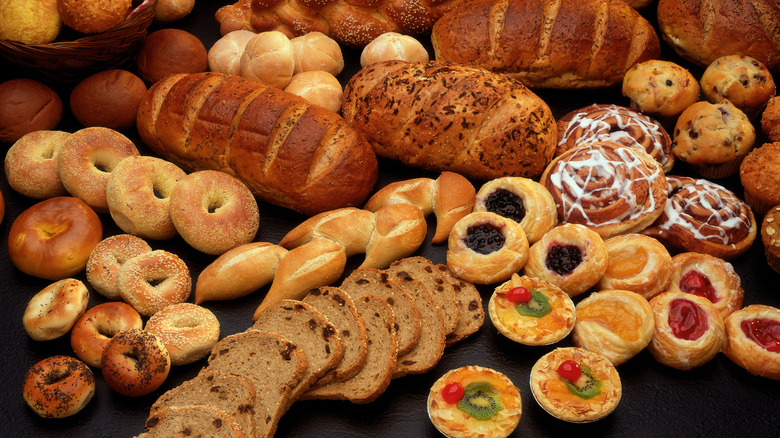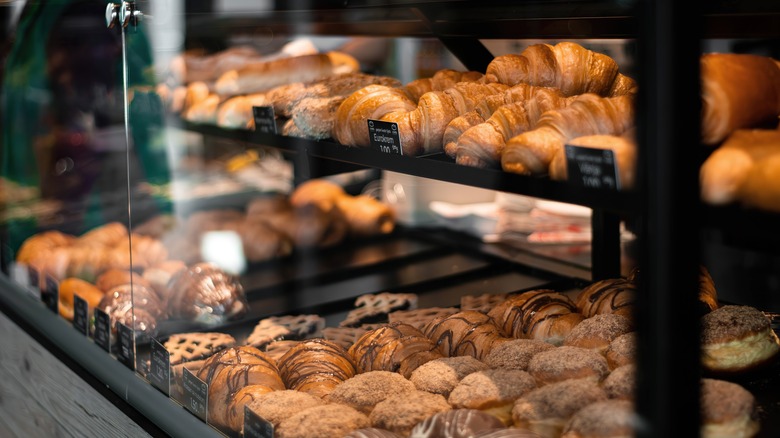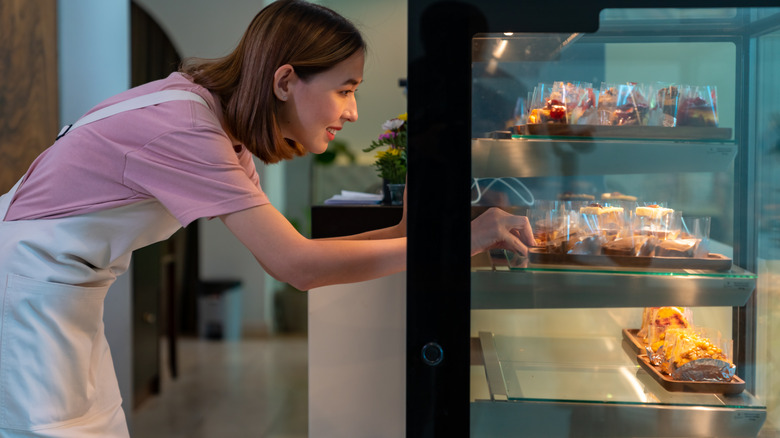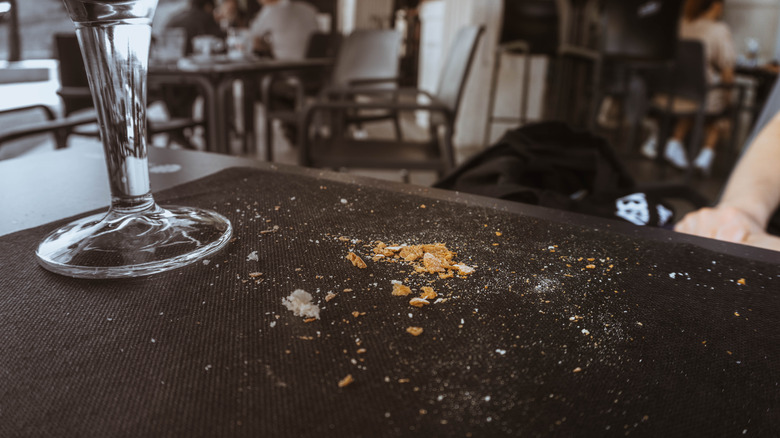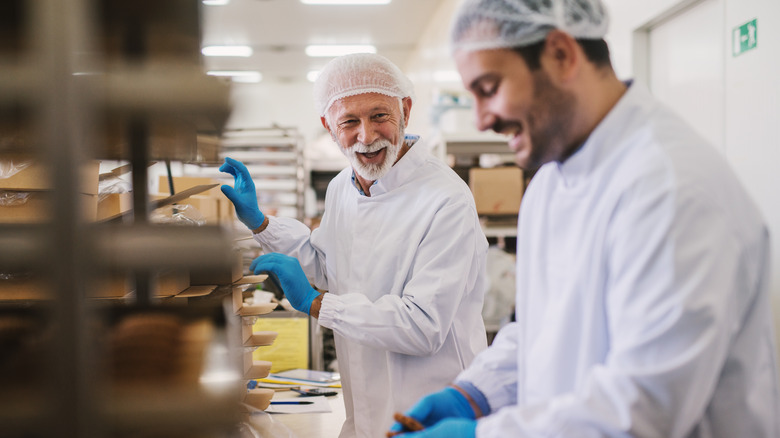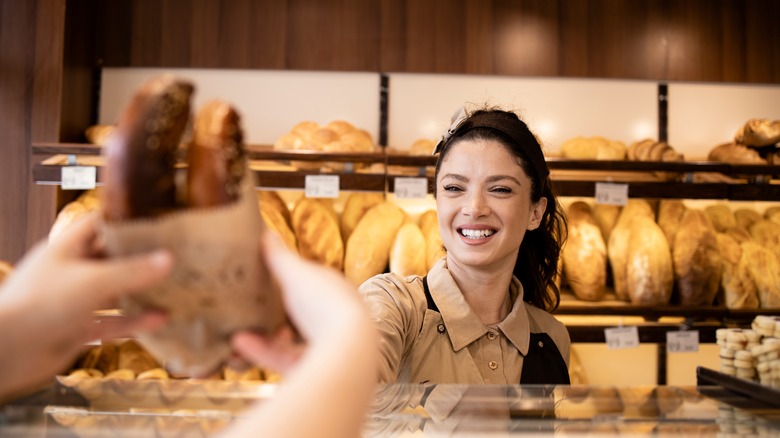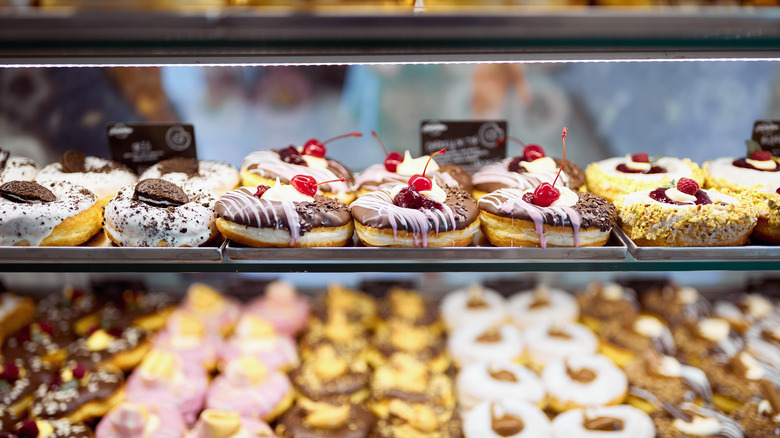Red Flags At A Bakery You Shouldn't Ignore
There are few sensations more satisfying than walking into a good bakery. It's literally a feast for the senses – from the enticing scent of butter and yeast that hits your nose as you enter to the ambient heat from the ovens to the sight of the jewel-like treats on display and the welcoming voices of friendly staffers taking your order. All of this, of course, is just a preview of the main event – the fun of making your selections and the pleasure of your first bite into a freshly-made croissant or cookie.
But not all bakeries are created equal. Untalented or inexperienced bakers can turn out mediocre products, and being a good baker and being able to run a good bakery are not the same thing. Looks can be deceiving – sometimes the best-looking pastries can be profoundly disappointing when you taste them. And while some bakers strive to use the best possible ingredients for their baked goods, less-scrupulous (or more cost-conscious) bakeries may settle for cheaper, lower-quality flavorings and ingredients. So when checking out bakeries, how can you tell which will be winners and which will be duds? Here are some red flags to look out for when checking out a bakery – if you see these, you'll know it's best to move on.
You smell cleaning liquids, not baked goods
When shopping for food, it's smart to look for cleanliness in the shops or restaurants you patronize. As Anthony Bourdain noted in Kitchen Confidential, the level of cleanliness of public areas of a restaurant (such as bathrooms) is an indicator of the level of cleanliness in the back of the house, where the food is prepared and stored. If a restaurant or specialty purveyor can't be bothered keeping its public areas presentable, Bourdain argued, what does this say about their attention to the cleanliness of areas the public doesn't see?
But while cleanliness is next to godliness, especially where food sales are concerned, too sterile of an atmosphere can be a red flag. For instance, if the first scent that hits your nose when you walk into a bakery is cleaning chemicals rather than baked goods, that's a sign something is off, celebrity pastry chef Duff Goldman told Insider. It could simply reflect a lack of attention to the customer experience, Goldman said – but taken along with an absence of baked-good scents, it could also indicate that the bakery's offerings weren't baked on the premises.
Cracks and crevices are filled with crumbs
While you don't want to be hit by a huge whiff of ammonia or pine cleaner when you walk into a bakery, cleanliness and sanitation do matter. So when checking out a new bakery, take a good look around – from the condition of the shop, would you feel safe buying and eating its products? "Check to see if the bakery is clean," advised Jasmine Mitchell of JCarmel's Pastries and Custom Cakes. Related to this, celebrity baker Duff Goldman told Insider that crumbs or debris in the corners of display cases – details that a careless employee might not notice – can make or break the bakery experience for him.
For Cynthia Carr, owner of Cakes by Cynthia, dirty countertops, floors, and equipment are dealbreakers. "These are all potential breeding grounds for bacteria," she said. Nicole Pomije, founder and owner of TheCookieCups.com, agrees. "I would not go back to a bakery or any other food establishment that seems 'dirty' when you walk in. Cleanliness goes a long way," she said. "If the floor is dirty, if the coffee machine looks like it has not been cleaned, [these are] general things that can be signs of other potential issues in the kitchen.
There's a suspiciously large variety of goods for sale
Here's a dirty little secret many bakery professionals would rather you not know: Not all bakeries actually make all the products they sell. Indeed, it's a fairly common practice for restaurants and bakeries to outsource the production of at least some of their baked goods.
Even in Paris, arguably the world epicenter of artisanal bread and pastry-making, it's becoming startlingly common for bakeries to offer pre-made frozen baked goods made offsite. This is because while the cost of making good-quality pastries has risen rapidly, customers' perceptions of what baked goods are really worth has not—so to stay in business, many bakeries have resorted to selling cheaper, pre-made goods. Some trade groups have estimated that as many as 80% of the pastries sold in French bakeries are mass-produced.
One of the red flags that might indicate pre-made pastries is an unusually large variety of goods on offer. While a good bakery should be expected to have a good assortment of treats, an inventory that seems disproportionately large for the size of the establishment – especially if there doesn't seem to be a big kitchen or a sizeable baking staff in the back – suggests a lot of the production is being outsourced. "If there are 45 products, be careful, something's wrong," chef Thierry Marx told The Washington Post.
Rolls and breads look wrinkly on top
When you enter any bakery for the first time, chances are your eyes will gravitate automatically to the pastry case. And when they do, don't just look to check the choice of offerings and their prices. Instead, take a close look at the baked goods and their overall texture and appearance, because this can indicate how fresh they are. For instance, Carr and Mitchell both note that if a pastry looks faded or uneven in color, it's probably been sitting around a while.
A good sight test for yeasted goods is to give them a quick check for unexpected wrinkles on top, which can indicate staleness, celebrity pastry chef Duff Goldman told Insider. This is because while baked goods expand and take in moisture as they bake, they gradually lose that moisture after they're baked. This dehydration causes the molecules in bread or pastry to shrink, causing the structure to collapse and contributing to a wrinkly texture. Of course, some baked goods improve with a bit of aging (such as fruitcake) and stale bread has its place (seek it out if you're planning to make croutons or bread pudding) but if you've got your heart set on delicate, fluffy breads, steer clear of any wrinkled ones.
Everything looks a bit too perfect
One of the joys of exploring a bakery is eating with your eyes – if you're lucky, you'll encounter a case full of colorful, attractively decorated items in a range of shapes and colors. And if you've ever tried your hand at baking yourself, you'll admire the skill and handiwork that went into getting all those layers into the croissants and getting all the pastries of the same type precisely and identically shaped and iced – how is it even possible for regular people to do that?
The answer is it may not have been. While master bakers can indeed create exquisitely decorated pastries by hand, true masters are few and far between, and most handmade pastries you'll encounter in good bakeries will bear the mark of human handiwork – they'll still look professional, but the swirls on each cookie may be slightly different, or an occasional drip or wiggle will appear in the iced lines. In contrast, if all the pastries look completely identical as if they were pumped out by a machine, they probably were. "Real baked goods are not always perfectly uniform in shape or size," Carr warned. If all of the bakery's products look like they came out of a factory, it may be a sign that they are using artificial ingredients or preservatives."
Prices are suspiciously low
We all love bakeries because they offer us affordable luxuries. Even if we can't spring for a three-course French feast, we can still indulge in a touch of luxury with an éclair or mille-feuille, and chances are, it will cost less than a fast-food burger. But as in all areas of life, you get what you pay for at a bakery. Of course, you'll want to avoid getting ripped off, but if you're seeking pastries made hand by skilled bakers, you should be ready and willing to subsidize their hard-earned salaries. And if you crave the flavor of good pastries made with real eggs, butter, and natural flavorings, expect their price to reflect the cost of these ingredients. "Prices that are too low can be a sign that the bakery is using low-quality ingredients," Carr warned. Michell agrees. "I notice the quality is better with fair pricing," she said.
In addition, suspiciously low prices can be yet another sign of industrially made, rather than handmade, products – faced with growing ingredient and labor costs and fearing customers will refuse to pay significantly higher prices for their baked goods, many bakeries have turned instead to cheaper, pre-made products. Some of these can be pretty good — but if you want something unique and special, prepare to pay more for it.
Display cases are smudged
Spend any time at a bakery, and you'll see the display case is the center of the action. Pretty much everyone who enters the bakery will touch it at some point. This, of course, is totally normal and expected, but when you look into a bakery's display case, you should see pastries, not a bunch of fingerprints on the glass. "Look at the desserts displayed to review if the glass, tables, and displays are clean from food residue," Mitchell advised.
A smudgy display case, of course, won't kill you, but it can be a sign of a less-than-polished operation. Good bakery operators know that neatness matters – not just for sanitation and safety purposes, but because of the message it sends to customers entering the shop – clean displays are simply more visually appealing to customers, and a bakery that takes its operations seriously will know this. Moreover, careless maintenance of the outside of a display case may reflect equally sloppy cleaning of the inside, where the food you're eating is stored. Ideally, bakeries should thoroughly clean their display cases inside and each at the end of each day, emptying them completely and carefully removing any food residue before sponging them down with food-safe cleaning solution.
The seating area's a mess
Good bakeries come in all shapes and sizes, and not all will have the same amenities – some only have enough room for a few customers to come in, choose what they want, then leave. But others have seating areas where patrons can linger and enjoy their treats. Smart bakery owners know that a welcoming seating area can be an important part of their branding, and some intentionally include homey seating, warm lighting, and sometimes even customized playlists to add to the customer experience.
Serious food lovers know, however, that even modest, bare-bones eateries with plastic chairs and fluorescent lighting can offer genuinely tasty treats – so there's no need to avoid a bakery just because the owner's interior design skills (or budget) are lacking. But no matter what the ambiance is, take a look around before having a seat. Are the tables clean, or still covered with crumbs from the last customer? And if someone is regularly circulating the area to clean the tables, is he or she using a clean cloth each time? If not, this could be a sign of poor sanitation practices elsewhere. While you're there, also look out for unswept floors or signs of insect or other vermin infestation – these are obvious red flags indicating problematic sanitation practices.
The bakery staff isn't wearing gloves or hairnets
Aspiring chefs and bakers learn early in their training to make sanitation a priority – in cooking schools, courses on sanitation and food safety best practices are among the first that new students must enroll in. And among the sanitation principles they learn is that the safety of the food they serve starts with their own cleanliness. According to the Food Safety Authority of Ireland, food service employees should wash their hands before starting work, before and after handling food, after cleaning tasks, and after eating, using the bathroom, sneezing, or coughing.
While you won't be able to directly see if safe hand-washing and other food-handling practices are followed in your local bakery, you can get an overall sense of how seriously the staff takes sanitation by how they present themselves: Are they clean and well-groomed, or unkempt? Are any of them visibly sick? Bakery staffers who appear unconcerned with their own grooming may not be meticulous hand-washers, and while most of us have powered through a day of school or work while sick, it's not a safe practice in food service. Also, look to see how employees are handling your food. For Carr, a big red flag is "employees who are not wearing hairnets or gloves." Similarly, Mitchell says she would walk out of any bakery where staffers are "not properly handling desserts with gloves or paper."
You can't get a straight answer about ingredients or help with complaints
Good cooks and bakers are passionate about their work and eager to talk about their handmade products. And if they're smart, they make sure their employees are able to talk up the day's offerings to customers and answer any of their questions about the menu – this is why it's a common practice for chefs to hold tasting meetings for their waitstaff when introducing new menu items. Bakeries are no different. While no one expects staffers behind the counter to be master bakers themselves, they should at least be able to answer basic questions about the offerings and their ingredients. In addition, bakeries that want to survive in a crowded marketplace should aim for friendly, helpful service.
So if the person behind the counter at your next bakery visit freezes like a deer in headlights when you ask about what's in a particular pastry or when or how it was made, tread with caution. While it could be just a case of a nervous new employee or their familiarity with a second language, it could also indicate poor training practices or worse. "If a bakery is unwilling to answer questions about their ingredients or practices, it may be a sign that they have something to hide," Carr said. And if the staff is hostile or just unhelpful, that's a good sign that you'd be better off shopping somewhere else.
It's the end of the day, and display cases are still nearly full
Freshness is key in a good bakery – so much so that bakers in most bakeries begin their workday in the predawn hours in order to ensure the first batch of fresh new bread and pastries are ready in time for breakfast and the first wave of customers. Because freshness is such a priority, bakeries aim to make only the quantity of product needed to last them through the end of the day. Any that's left over is later repurposed into other preparations (such as cake pops, which were devised as a way to make use of day-old cake), donated to food banks, sold at a deep discount, or, sadly, tossed.
This means if you go into a popular bakery late in the afternoon, don't be surprised to find the display case nearly empty – this is exactly what's supposed to happen. "I think it's a good sign when the counter is more bare — it means everything coming out will be fresh-baked," Pomije said. However, if you wander into an unfamiliar bakery late in the day and the display case is fully loaded, look out. "If it's a full counter and it's 3 p.m., more than likely products may have been sitting out for a few hours," Pomije said. "A full counter at 8 a.m. is okay."
